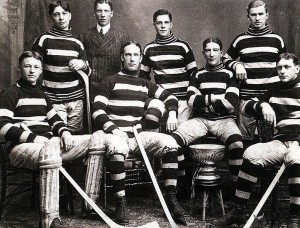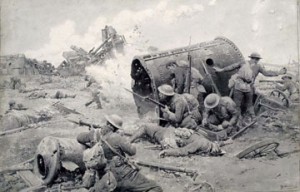A Silver Seven Legend and the Sugar Factory
Frank McGee
In 1967 the family Ferguson returned to Canada and for three years lived at Dartmouth, Nova Scotia. There was much to learn and amongst the first rediscovered interests were hockey, the National Hockey League, radio broadcasting and Foster Hewitt, and black and white televised games. I recall tuning in the gentle tube radio with its soft voice that seemed to capture reception from across North America. There was the great voice of Mr. Hewitt, and the names of the original six team players I heard were memorized and filled my imagination with endless winning goals playing road hockey, though in reality it was a lot of sidewalk jostling.
Cast in stone from the outset the original six N.H.L. teams live in fond memory even today. I enjoy books on the subject and recall my first hockey history book authored by Brain MacFarlane. In that book, of which the title has escaped my memory, I learned there were even earlier teams than the original six with dashing names like the Montreal Maroons, the Vancouver Millionaires and the Ottawa Silver Seven. It was amongst these seven from Ottawa that I learned of the legendary star and Hall of Famer Francis Clarence “Frank” McGee, a one eyed hockey player who scored 14 goals in one Stanley Cup game. I was astonished and more so – the picture of the team with Frank McGee may be the earliest archival image I can recall.
It may make one wonder what Frank McGee a professional hockey player from 1902 – 1906 has to do with military history and the Somme in particular?
It is that same Frank McGee, with one eye, who served during the Great War as a Lieutenant with the 21st Battalion C.E.F. Despite his injuries, received in an amateur hockey game, McGee managed to cleverly avoid failing the eye examination and entered into service. On December 17, 1915 McGee was wounded at Dickebusch, Belgium when the armoured car he was in was blown up by a high explosive shell. Sent to England for recovery he chose to return to his battalion in August 1916, rather than taking a posting at Le Havre. A month later, September 16, 1916 Frank McGee was killed in action on the Somme during the fighting for the Sugar Factory (Refinery), Courcelette, France. He was 38 years old.
Frank McGee’s parents, John Joseph and Elizabeth McGee, of Ottawa, Ontario also lost a second son to the Great War. Major Charles Edward McGee served with the 5th Battalion C.E.F. and was a veteran of the Boer War 1899-1902. Charles was killed in action 26 May 1915 aged 39 years. Both brothers are commemorated on the Vimy Memorial.
Did you know?
The 21st Battalion C.E.F. had a regimental pipe band comprising 14 pipers and 5 drummers. The unit’s March Past was “Scotland the Brave”, but the 21st was not considered a Scottish regiment within the Canadian Expeditionary Force. The unit’s Pipe Major Ian Ross McKenzie, who was commissioned, was killed at Cambrai October 11, 1918. Three of the unit’s Pipers, Hugh McKenize, John Robert Coghill and William Currie were awarded the Military Medal for Bravery in the Field. Currie was later commissioned and was also awarded the Military Cross. All four were Scottish born.



Mr. Ferguson,
The claim that McGee avoided/cheated the eye examination is – as I have recently argued – questionable. Evidence indicates that everyone in the unit knew who he was at the time of his enlistment and, therefore, would have known about this eye injury/visual limitations.
See: Nic Clarke “‘The Greater and Grimmer Game’: Sport as an Arbiter of Military Fitness in the British Empire – The Case of ‘One-Eyed’ Frank McGee.” The International Journal of the History of Sport 28, no. 3 (2011): 604-622.
A condensed version of mt argument can be found here:
http://www.canadianmilitaryhistory.ca/hockey-war-and-military-fitness-by-nic-clarke/
Mr. Clarke,
I am very pleased that you have added to our blog and I completely agree that everyone knew who Frank McGee was.
I would be curious if you have looked into the case of Rowland Bourke VC DSO who suffered from defective eyesight and was not accepted for service in Canada during the First World War? Bourke joined the Royal Naval Volunteer Reserve in England serving aboard Motor Launches and subsequently received the Victoria Cross and Distinguished Service Order.
I was most interested in your article that you kindly provided as a link. Perhaps we will have the opportunity to chat again?
Paul
Paul,
I would be happy to chat. I do not know of the case you cite.